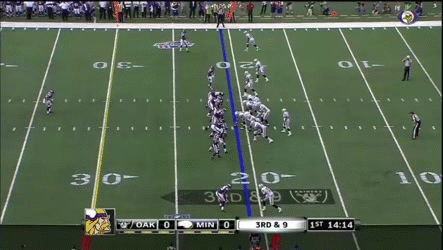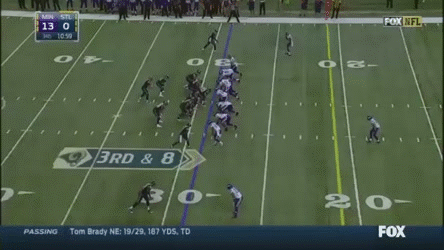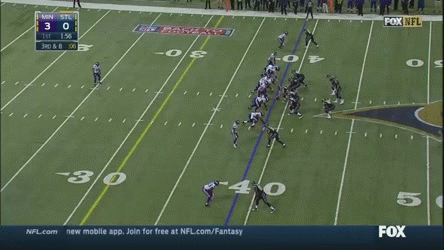http://vikingsjournal.com/_/minneso...garing-the-a-gap—zimmers-pressure-du-jour-r92
Sugaring the A Gap—Zimmer's Pressure Du Jour
Sep 10 2014 04:10 AM | Arif Hasan in
Minnesota Vikings
New head coach Mike Zimmer has been experimenting with pressure packages throughout the offseason and preseason, and in the first regular season game against the St. Louis Rams continued a strategy he's favored his entire career.
Image courtesy of Brace Hemmelgarn-USA TODAY Sports
Mike Zimmer is neither the kind of defensive coordinator to rely on the predictive playcalling of the previous regime, nor the kind of coordinator that relies on aggressive blitzing, like Houston, Arizona and Oakland did last year.
And though the defenses haven’t been “revealed” in the preseason, a lot of what Mike Zimmer has done in Cincinnati has shown up in camp and in the exhibition games that give us some clue as to his philosophy, and they appeared in the game against St. Louis.
On first and second down, Zimmer defenses tend to play to the fundamentals, but when they encounter a “passing down,” Zimmer really likes to let go.
One of the best ways to create unbalanced pressure while still dropping enough players into coverage—something that inspired the creation of the zone blitz—is to fake pressure and create pressure from somewhere else. Generally speaking, this is best done through showing pressure up the middle, often called “sugaring the A gap,” the two gaps between the center and the guards.
This is an extension of the nomenclature used to designate gap assignments, with the B gaps between the guards and tackles and the C gaps between the tackles and the tight end (or the sideline). Sometimes, the alley between the tight end and the sideline is referred to as the D gap, or simply the alley.
The important point here, though, is that showing “double A gap pressure,” or presenting a possible blitz through both A gaps, causes the most trouble for offensive lines and quarterbacks in determining blocking assignments.
The double A gap blitz is a product of Jim Johnson, the legendary former Philadelphia Eagles defensive coordinator, and it developed as a consistent defensive tactic in response to the increasing effectiveness of the West Coast Offense. Famously, Steve Spagnuolo used the tactic to great effect as the defensive coordinator of the New York Giants in 2007, responsible for New England’s ominous Week 17 close game and their famous loss in the Super Bowl that same, record-setting year.
Mike Zimmer’s use of the blitz package mirrors its most common usage patterns in recent history, as Tim Layden
writes in Sports Illustrated:
Quote
It begins most often with the defense's nickel personnel—five defensive backs—on the field with four down linemen and two linebackers in a 4-2-5 configuration (although it can be run from various other sets). As the offense reaches the line of scrimmage, the two linebackers move menacingly into the A gaps. If the quarterback is under center, the 'backers are eye-to-eye with him. "At that point it's mental gymnastics," says Jon Gruden, the former Raiders and Bucs coach who's now an analyst on Monday Night Football. "There's no doubt there's going to be some penetration in the middle if they blitz, and it's going to mess with your blocking schemes."
In terms of how it affects pass protection schemes, it’s pretty simple. The defense is showing a seven-man blitz, which creates issues. If the protection unit is in man protection, then there’s a man that’s free (because teams are often in 6-man protection, at best). If the protection unit is in slide, or “area” protection, then a running back is responsible to cover the backside of the slide because the offensive linemen move into the gaps (zones) they are assigned to protect, leaving the backside free.
Usually, full-slide protection is used to protect on bootlegs and rollouts. It also leads to mismatches—though slide protection theoretically makes assignments easier to deal with stunts and twists, it can create issues if the defense has schemed a mismatch with a quicker defender attacking a slow-footed guard, or a tight end dealing with a powerful tackle.
The bigger difference in assignment is for the running back—offensive linemen in man protection will still swap stunting defenders. Instead, the running back is responsible for following a linebacker and protecting the quarterback from that specific person regardless of the gap they go through.
More often than not, offensive lines will engage in some sort of combo protection, explicit or not, in order to figure out their pass protection. That is, even those nominally engaged in man protection will pick up defenders in their area and expect others to do the same when not engaged.
The final method of protection involves dual-reading, where a player must read two players and make a call about who to block. Most often this involves running backs in man (or combo) protection, where they will read the linebackers inside-out (Mike to Sam), covering their blitzes in that order (if both blitz, the running back blocks the Mike).
These become more complicated when safeties and slot corners threaten to blitz as they not only screw up the assignments but add players that need to be accounted for. Generally speaking, Mike Zimmer and defenses in general will not likely rush more than seven, as the offense is probably going to send four of its five eligible receivers out in routes, and that would leave players uncovered.
Blocking with more doesn’t usually result in more protection; as Aaron Rodgers noted not too long ago, you may be able to better protect the quarterback
by giving him enough receiving options. In the case of dealing with seven or eight-man looks, six-man protection is usually fine because a receiver will get a free release, and in an offense with sight adjustments (Schottenheimer’s offense with St. Louis includes them, though not to the degree that McDaniel’s offense with New England does), that receiver should adjust their route to be wide open.
In this way, the quarterback is “responsible” for the extra rushers. In the example above, where the running back dual-reads the Mike and the Sam and both rush, the quarterback is the one who accounts for the Sam by throwing it hot to the checkdown or hot route—the new route that the receiver runs in response to the blitz.
Sugaring the A gap was responsible for the first third down success in the preseason, when Schaub’s receiver failed to adjust to the blitz look and ran his normal route while Schaub expected him to run a comeback. The pressure and the failure to respond led to the incompletion:
In the end, the Vikings only ended up rushing five and confused coverage calls by dropping players like Brian Robison into coverage (if, for example, the tight end was supposed to be the hot route, Robison would have been able to cover it).
There are some clear issues with man blocking, which include the fact that a stunting Sharrif Floyd would have been very difficult to handle on a stunt. But slide protection would have caused issues, too:
That leaves the running back to either block a defensive end (something Norv Turner has expressed a few times something he doesn't want
his offense to do) or the safety. Two free rushers are a little too much to handle.
In the end, the Oakland Raiders chose half-slide, half-man protection like the vast majority of teams on the vast majority of snaps. Though this would generally have done well against a greater number of rushers than the Vikings eventually sent, Minnesota still put pressure on the quarterback while dropping six in coverage.
Against the Rams, the Vikings showed double A gap pressure again, this time leading to a sack by Harrison Smith, coming off the edge again.
The Vikings showed eight-person pressure and rushed seven, leaving one defender to cover each receiver running routes, also known as "man-free" coverage. If the Rams kept a tight end in to block the seventh person (which would have shifted the assignments down the right side of the line), then the safety up top, Robert Blanton, would have rotated into a Cover-1 look shaded to the strength of the formation (where two receivers are lined up).
Instead, he picks up crossing receiver. Because of the added difficulties of this kind of pressure, defensive linemen who do not immediately penetrate drop back into short zones in order to disrupt any hot routes. The pressure package looked like this, and it was designed to put the center in a bind.
And though the center determined who to block quickly enough, the other A gap rusher needed to be picked up. With the running back occupied with Anthony Barr, Harrison Smith had a free release off the edge—both the left tackle and left guard had assignments with Everson Griffen and Sharrif Floyd.
The biggest beauty to this play design, however, is who the quarterback is responsible for: Harrison Smith.
Generally speaking, the person the quarterback is responsible for with seven- or eight-man pressure is a person who is playing on the same side of the formation as his progression. In his pre-snap reads, the quarterback needs to make a determination as to which half of the field he will begin his progressions (where the first and second reads almost always are) before he scans the rest of the field.
That creates an issue in this case because Harrison is coming off the open side of the formation (the "1" in the 3x1 alignment the Rams played on that down), where the quarterback wasn't beginning his reads. While in a broad sense this is the quarterback's fault (the Vikings were signalling off-man, which they ended up playing)—the receiver on that side of the field breaks inside to get open against that look—it's situationally still a loss because the Rams were on 3rd and 8, and that likely would not have converted.
In either case, the Vikings come out ahead. The protection scheme had an answer for everybody, even if the quarterback didn't execute that answer, but those responses would have led to a quick, short gain on third and long. Further, there's a chance Robert Blanton could have peeled off of his man to intercept the ball thrown to the open side of the formation.
Other solutions could have put the running back on Harrison and slid the center, right guard and right tackle inside, with the quarterback throwing hot against Captain Munnerlyn. Unfortunately for the Rams, it creates the same problems, as Tavon Austin ran a route depth at two yards and Lance Kendricks runs his spot route three yards from the line of scrimmage.
It still would have been better to dump off to Tavon Austin and hope for yards after the catch—that's why he was drafted—but the Vikings will consistently take short yardage passes on third and long and be happy to do so.
In large part, this was successful because the Rams' third string quarterback, and undrafted sophomore from Southern Miss, wasn't ready to handle that kind of pressure, and he couldn't direct the offensive line to maximize his time in the pocket. Some quarterbacks like to call for a rollout there, but that likely would have caused issues, as the Vikings on the strong side (Munnerlyn and Robison) would likely not have bit on play-action on third and long, or at the very least would play contain before reverting to rushing an unprotected passer.
Zimmer doesn't always send linebackers to rush the A gaps when showing six, seven or eight man pressure, but the threat of the blitz confuses blocking assignments enough that twists will be particularly effective.
That's another wrinkle to that specific rush the Vikings put on Austin Davis, with Robison and Johnson both taking a step upfield in the gaps they traditionally attack before moving inside—Greenway abandoning the A gap shortly before Johnson attacks it can often lead to unaware blockers allowing pressure. In fact, Johnson does get inside and gets to the quarterback; he may have been able to take him down if Harrison didn't do it first.
Sugaring the A gap doesn't have to lead to linebacker blitzes in order to be effective, and there are other instances when the Vikings dropped both linebackers in coverage while still getting pressure as a result of this tactic.
Here, the Vikings dropped both linebackers and only rushed four, but were still able to get the one-on-one matchups they wanted in order to force the quarterback to throw quickly—the center didn't double anyone.
In this case, the quarterback was able to get the ball to his receiver and was one yard short, but rushing throws is still good. Note that the running back delayed his release into a route simply because of the threat of pressure.
Like any blitz or pressure package, it isn't magic. But it's definitely a weapon in the Vikings' arsenal, especially on third down, when the sticks are seven to twelve yards away from the line of scrimmage. The Vikings sacrifice some speed on their pass drops and occasionally will sacrifice players in coverage, but the payoff seems to be well worth it.
Though the Vikings haven't done anything in this regard that hasn't been done hundreds of times in the NFL (Jim Johnson brought it into the fore in 1994), but it's a healthy addition to a defense that badly needed a shot in the arm.









